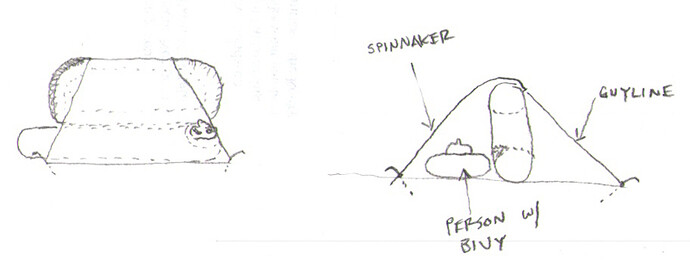In another thread, blisterfree brought up the idea for using your packraft as the central structure of a lean-to tarp system. I took his paragraph and drafted a quick sketch of what I thought this might look like.
YEAH! You just about nailed it Sam! Good job and thanks…
The side of the awning that attaches to the raft might run a little longer, though, given the actual position of the corner lash tabs. So the coverage might be better, although still not full-body coverage.
I’m sure the concept will seem progressively more fruity under the harsh light of further analysis. But at least I’ve exorcised it out of me, with Sam’s generous artistic assistance.
I was thinking of adding tie downs or something with my raft build to allow it to double as a shelter/tarp or some how incorporate it into a shelter.
If you have paddles with you, why not try setting something up using that as structure?
I was concerned about the additional opportunity of hurting the raft (waking up to a boat that won’t hold air [although at the moment mine still wont] wouldn’t be fun).
for me the addition of an equal area piece of fabric (a few ounces) would outweigh (literally as well… nice) the opportunity to hurt my boat.
If you have a spray skirt, I’d bet you could modify that some to create a wall of your shelter, maybe use the rock and loop method so it didn’t actually have to be modified.
Damaging the boat would obviously be a big concern, which is why I wouldn’t want to use the spraydeck in conjunction with a shelter, or as a groundsheet, etc.
What Sam’s diagram of my idea shows is a way for the ultra-gram-weenie who normally uses a tarp to avoid having to pack half of that tarp. Yes, the design also eliminates the need to pack hiking poles or look for sticks as tarp supports, but then a break-apart paddle would do likewise. So it’s probably a somewhat academic concept that doesn’t have irresistible application in the real world. This design could be modified, though, to use half of a paddle at the far corners of the “awning” to raise it up a bit and create more interior room. And the pattern for the foot end of the awning could probably be cut at a deeper angle to offer modest coverage for the lower legs, especially if attaching the foot end of the awning to the lower corner lash tab of the vertically-oriented raft.
in a jam it would be a good option. options are always good, plan A rarely works need a plan B,C,ect…
My thoughts when drawing it where that rather than using the raft as part of the shelter one could simply use two paddle-halfs. The limiting factor there is you don’t get the added wind and rain protection that the raft would provide.
In hindsight, trying to incorporate the raft into a shelter design to save weight - either by downsizing from a standard size tarp or leaving the usual shelter at home - is a natural impulse, given the raft’s unavoidable added weight, but it’s all somewhat in vain. Except maybe for a contortionist, the raft isn’t sized or shaped right to replace or “meld with” an existing shelter. The best it can really accomplish in any kind of weather is to render a tarp or tent optional for WP/B bivy users, as demonstrated on Sam’s recent outing with Backpacking Light.
A break-apart paddle probably offers more in the way of functional dual-use of equipment than the raft itself, by eliminating some of the excuse for carrying trekking poles, either as tarp/tent supports or for balance while wet-foot walking.
Sam’s drawing is great though. I hope it outlives its usefulness. :mrgreen:
I would use the Packraft for a windbreak rather than as a support for the tarp.
A multifunction packraft sounds good, but what happens it one of the functions don’t work ?? it could be a long walk home. 
The OP’s diagram shows what I believe to be a fairly low-risk use of the raft, if you look at how it’s actually being incorporated into the shelter. Ergo, I’m going to keep my self-criticism focused on the “solution without a problem” aspect of the design.
